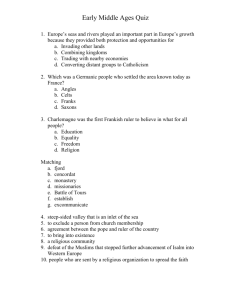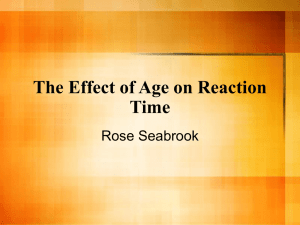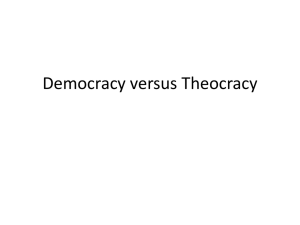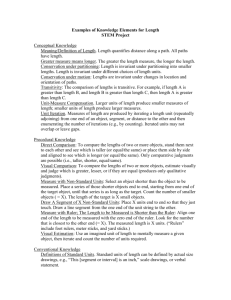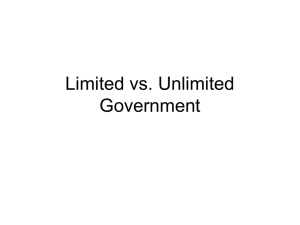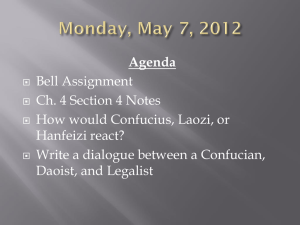Complete List of Prime Number Rulers
advertisement
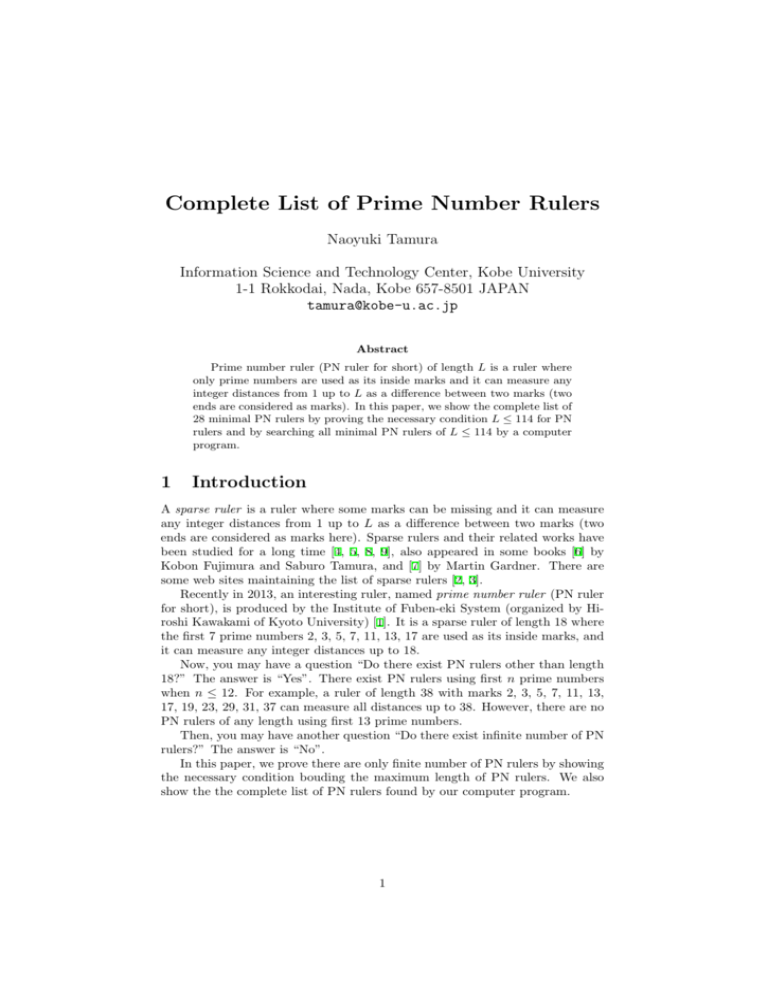
Complete List of Prime Number Rulers
Naoyuki Tamura
Information Science and Technology Center, Kobe University
1-1 Rokkodai, Nada, Kobe 657-8501 JAPAN
tamura@kobe-u.ac.jp
Abstract
Prime number ruler (PN ruler for short) of length L is a ruler where
only prime numbers are used as its inside marks and it can measure any
integer distances from 1 up to L as a difference between two marks (two
ends are considered as marks). In this paper, we show the complete list of
28 minimal PN rulers by proving the necessary condition L ≤ 114 for PN
rulers and by searching all minimal PN rulers of L ≤ 114 by a computer
program.
1
Introduction
A sparse ruler is a ruler where some marks can be missing and it can measure
any integer distances from 1 up to L as a difference between two marks (two
ends are considered as marks here). Sparse rulers and their related works have
been studied for a long time [4, 5, 8, 9], also appeared in some books [6] by
Kobon Fujimura and Saburo Tamura, and [7] by Martin Gardner. There are
some web sites maintaining the list of sparse rulers [2, 3].
Recently in 2013, an interesting ruler, named prime number ruler (PN ruler
for short), is produced by the Institute of Fuben-eki System (organized by Hiroshi Kawakami of Kyoto University) [1]. It is a sparse ruler of length 18 where
the first 7 prime numbers 2, 3, 5, 7, 11, 13, 17 are used as its inside marks, and
it can measure any integer distances up to 18.
Now, you may have a question “Do there exist PN rulers other than length
18?” The answer is “Yes”. There exist PN rulers using first n prime numbers
when n ≤ 12. For example, a ruler of length 38 with marks 2, 3, 5, 7, 11, 13,
17, 19, 23, 29, 31, 37 can measure all distances up to 38. However, there are no
PN rulers of any length using first 13 prime numbers.
Then, you may have another question “Do there exist infinite number of PN
rulers?” The answer is “No”.
In this paper, we prove there are only finite number of PN rulers by showing
the necessary condition bouding the maximum length of PN rulers. We also
show the the complete list of PN rulers found by our computer program.
1
2
3
5
7
11
13
17
1
2
3
4
5
6
7
8
9
10
11
12
13
14
15
16
17
18
Figure 1: A PN ruler of length 18
2
Prime Number Rulers
Let M be a set specifying possible marks. A ruler of length L on M is a nonempty sequence (a1 , a2 , . . . , am ) satisfying the following conditions where a0 = 0
and am+1 = L.
• a1 , a2 , . . . , am ∈ M
• 0 = a0 < a1 < · · · < am < am+1 = L
The sequence (a1 , a2 , . . . , am ) is called the marks of the ruler. A ruler is called
complete when any positive integer distance d ≤ L can be measured, that is,
d = aj − ai for some ai and aj (0 ≤ i < j ≤ m + 1). A complete ruler is called
minimal when the sequence is minimal, that is, any subsequence of its marks is
not complete for the same length.
A sparse ruler of length L is a complete ruler of length L on N (a set of
positive integers {1, 2, 3, . . .}).
A prime number ruler (PN ruler for short) of length L is a complete ruler
of length L on P (a set of prime numbers {p1 , p2 , p3 , . . .} where pn is the n-th
prime number).
Figure 1 displays a PN ruler (2, 3, 5, 7, 11, 13, 17) of length 18. Each distance d ≤ 18 can be measured as shown as arrows in the figure. The ruler is
not minimal. Two minimal PN rulers of length 18 are (2, 3, 5, 11, 13, 17) and
(2, 3, 5, 7, 11, 17).
3
Some Properties of Prime Number Rulers
Lemma 1. The length of a PN ruler is p + 1 for some prime number p.
Proof. Let L be the length of the PN ruler. To measure the distance L − 1,
there should be a mark at 1 or L − 1. Therefore, L − 1 is a prime number.
2
By Lemma 1, the length L of a PN ruler is even when it is larger than 3.
Let (a1 , a2 , . . . , am ) be a PN ruler of length L. We also assume a0 = 0
and am+1 = L. Since all prime numbers greater than 2 is odd, even numbers
occurring in ai ’s are only 0, 2, and L. Therefore, to measure an odd integer
distance d, one of d, d + 2, and L − d should be a prime number.
With this observation, the following theorem is proved.
Proposition 1. The length a PN ruler can not exceed 114.
Proof. We assume there is a PN ruler of length L > 114, and derive a contradiction. The assumption L > 114 can be replaced by L ≥ 128 since L − 1 is a
prime number from Lemma 1 and the next prime number larger than 113 is 127.
Because any prime number larger than 3 is either 6m − 1 or 6m + 1 for some
positive integer m, L is either 6m or 6m + 2. Now, we will derive contradictions
for both cases.
• Case when L = 6m ≥ 128. Let us consider to measure 33. As described in
the above observation, either 33, 35, or L − 33 should be a prime number.
However, 33 and 35 are not prime, and L − 33 = 6m − 33 is divisible by
3. It contradicts the assumption.
• Case when L = 6m + 2 ≥ 128. Let us consider to measure 119. Either
119, 121, or L − 119 should be a prime number. However, 119 and 121 are
not prime (divisible by 7 and 11 respectively), and L − 119 = 6m − 117 is
divisible by 3. It contradicts the assumption.
Therefore, there are no PN rulers of length L when L > 114.
4
Complete List of Prime Number Rulers
In the previous section, L ≤ 114 is shown as necessary condition for PN rulers.
We can list all possible length of PN rulers by checking whether (p1 , p2 , . . . , pm )
is a PN ruler of length pm + 1 or not for each m ∈ {1, 2, . . . , 30} (p30 = 113).
As the result, we obtain possible lengths of PN rulers as 3, 4, 6, 8, 12, 14, 18,
20, 24, 30, 32, 38, 44, and 62.
Table 1 shows the complete list of all minimal PN rulers found by our computer program. There are 28 minimal PN rulers. List of all PN rulers can be
easily obtained by adding extra prime numbers. For example, (2, 3, 5, 7, 11, 13)
is another PN ruler of length 14. There are 102 PN rulers in total.
5
Conclusion
In this paper, we studied PN rulers where only prime numbers are used as its
inside marks and it can measure any integer distances. We show there are only
finite number of PN rulers by proving the necessary condition bounding the
length of the PN ruler to 114. Through the execution of a computer program,
we obtained the complete list of 28 minimal PN rulers.
3
Table 1: Complete List of 28 Minimal Prime Number Rulers
Length
3
4
6
8
12
14
14
18
18
20
20
20
24
24
30
32
32
38
44
44
44
44
44
44
44
62
62
62
#Marks
1
2
2
3
5
5
5
6
6
6
7
7
7
8
8
8
9
10
11
11
11
11
11
11
11
14
14
14
Marks
2
2, 3
2, 5
2, 3, 7
2, 3, 5,
2, 3, 5,
2, 3, 7,
2, 3, 5,
2, 3, 5,
2, 3, 7,
2, 3, 5,
2, 3, 5,
2, 3, 5,
2, 3, 5,
2, 3, 5,
2, 3, 7,
2, 3, 7,
2, 3, 5,
2, 3, 5,
2, 3, 5,
2, 3, 5,
2, 3, 5,
2, 3, 7,
2, 3, 7,
2, 3, 7,
2, 3, 7,
2, 3, 7,
2, 3, 7,
7, 11
7, 13
11, 13
7, 11, 17
11, 13, 17
11, 17, 19
7, 11, 13, 19
11, 13, 17, 19
7, 11, 17, 23
11, 13, 17, 19, 23
7, 11, 17, 23, 29
13, 17, 23, 29, 31
11, 17, 19, 23, 29, 31
7, 13, 19, 23, 29, 31, 37
7, 11, 19, 23, 29, 31, 37, 43
11, 13, 19, 23, 29, 37, 41, 43
11, 17, 19, 23, 31, 37, 41, 43
11, 19, 23, 29, 31, 37, 41, 43
11, 13, 19, 23, 29, 37, 41, 43
11, 17, 19, 23, 31, 37, 41, 43
11, 19, 23, 29, 31, 37, 41, 43
13, 17, 23, 29, 31, 37, 43, 47, 53, 59, 61
13, 19, 23, 29, 31, 37, 41, 47, 53, 59, 61
13, 19, 23, 29, 31, 37, 43, 47, 53, 59, 61
4
References
[1] Institute of Fuben-eki system. https://www.facebook.com/fuben.eki.
[2] Perfect and optimal rulers.
prulers.html.
http://www.luschny.de/math/rulers/
[3] Sparse ruler. http://en.wikipedia.org/wiki/Sparse ruler.
[4] Alfred Brauer. A problem of additive number theory and its application
in electrical engineering. Journal of the Elisha Mitchell Scientific Society,
61:55–66, 1945.
[5] Paul Erdös and I. S. Gál. On the representation of 1, 2,..., n by differences.
Nederl. Akad. Wetensch. Proc, 51:1155–1158, 1948.
[6] Kobon Fujimura and Saburo Tamura. Pazuru Sugaku Nyumon (Introduction
to Math with Puzzles). Kodansha, January 1977. (in Japanese).
[7] Martin Gardner. The Incredible Dr. Matrix. Encore Editions, June 1977.
[8] John Leech. On the representation of 1,2,...,n by differences. Journal of the
London Mathematical Society, 31(2):160–169, 1956.
[9] B. Wichmann. A note on restricted difference bases. Journal of the London
Mathematical Society, 38(2):465–466, 1962.
5
